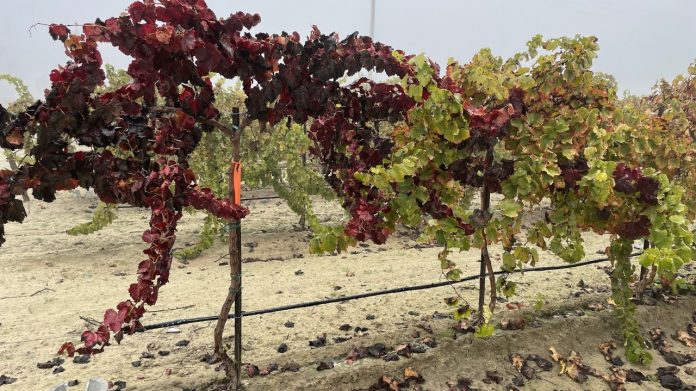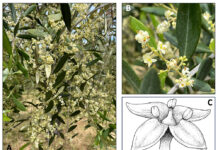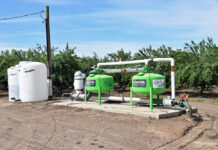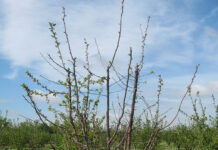
Grapevine canker diseases are commonly associated with fungal pathogens of the Botryosphaeriaceae, Diatrypaceae and Diaporthaceae families. These pathogens have been found and described in many cultivars worldwide. Symptoms include internal wood necrosis, stunted or poor shoot development after the budbreak and dieback of cordons or the entire vine. Cankered tissues may also exhibit dark fruiting bodies (pycnidia and perithecia) on the surface, which are responsible for releasing the spores that will lead to further infections in the vineyard.
A different wood canker disease was first detected in the San Joaquin Valley in 1989, affecting excessively vigorous young ‘Red Globe’ grapevines (Michailides et al. 2002). Since then, the disease has been observed on different cultivars, including Chardonnay, Grenache and Crimson Seedless. The pathogen was morphologically identified Aspergillus niger, a member of the group of black aspergilli, or Aspergillus section Nigri, and the disease was named as Aspergillus Vine Canker. From 2003 to 2010, Aspergillus vine canker was detected and monitored in Italy, affecting several table grape cultivars on different growing regions (Vitale et al. 2008, Vitale et al. 2012). In this case, three species of black aspergilli were associated (A. awamori, A. carbonarius and A. tubingensis). Recently, through a collaboration with UCCE farm advisors, we identified Aspergillus vine canker on Grenache and Malbec cultivars in Fresno and Sonoma counties, respectively. Symptomatic vines tested negative for viral infections.

Symptoms
Affected vines are easily distinguishable by their premature senescent leaves during the fall, while healthy vines are still green (Figure 1). A single vine can harbor multiple cankers located on different parts of the vine, including the trunk, cordon and spurs. Black sporulation is evident at the surface and underneath the bark of affected tissues, which is key to distinguish Aspergillus from other trunk pathogens that usually form fruiting bodies that are embedded in the wood (Figure 2). Internally, a brown discoloration is evident in the xylem near the margin of the cankers (Figure 3a), whereas the areas under the sporulation show necrosis and black discoloration near the bark (Figure 3b). In severe cases, the canker can girdle most of the vascular area.

Current Investigations
Our lab has been focusing on the specific identification of the causal agent of Aspergillus vine canker in California using molecular tools, particularly by constructing phylogenetic trees using DNA sequences of the calmodulin gene. Preliminary data suggest that our isolates correspond to Aspergillus tubingensis, a closely related species to the previously identified A. niger. Since morphological features cannot separate both fungal species, two hypotheses can be indicated, either the old and new isolates correspond to the same species (A. tubingensis) or they are different (A. niger and A. tubingensis). Coincidently, black aspergilli are known to cause sour rot on grape berries. In California, two species (A. niger and A. carbonarius) have been described as causal agents of sour rot disease on table grapes (Rooney-Latham et al. 2008). Therefore, we are currently studying the phylogenetic relationships between Aspergillus isolates from wood cankers and sour rot berries to understand accurately the etiology and epidemiology of both diseases.
Management Strategies
Aspergillus vine canker has not been thoroughly studied given its sporadic occurrence in California. Therefore, the only management strategies include cultural practices, such as obtaining clean plant materials, identifying diseased vines in the fall and removing affected parts by cutting them back below the canker during dormant season or removing the entire vine.
References
Michailides, TJ., W. Peacock, P. Christensen, DP. Morgan, D. Felts. 2002. Plant Dis. 86:75. https://doi.org/10.1094/PDIS.2002.86.1.75A
Rooney-Latham, S., C. N. Janousek, A. Eskalen, W. D. Gubler. 2008. Plant Dis. 92(4):651. https://doi.org/10.1094/PDIS-92-4-0651A
Vitale, A., Castello, I., Polizzi, G. 2008. Plant Dis. 92:1471. https://doi.org/10.1094/PDIS-92-10-1471B
Vitale, A., G. Cirvilleri, A. Panebianco, F. Epifani, G. Perreno, G. Polizzi. 2012. Eur J Plant Pathol 132:483–487 https://doi.org/10.1007/s10658-011-9906-z













